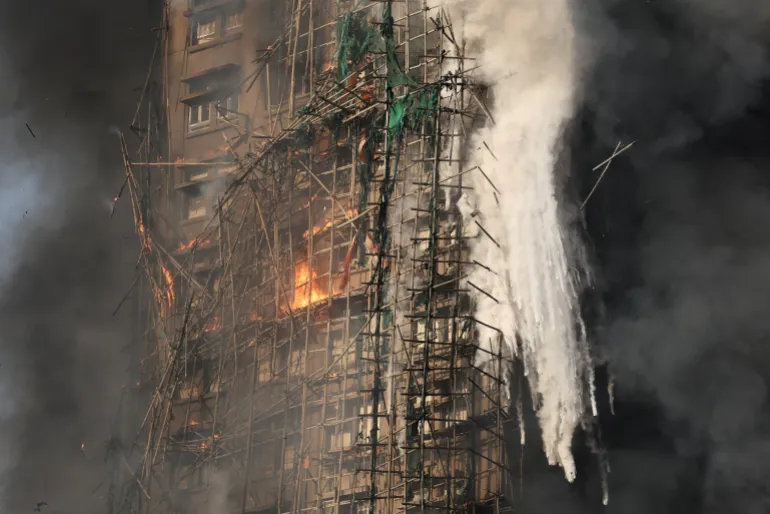Hong Kong’s deadliest fire in 63 years: What we know and how it spread | Construction News
At least 44 people have died after Hong Kong’s worst fire in 63 years tore through several high-rise buildings on Wednesday afternoon, officials said.
Firefighters are still fighting the blaze in the Tai Po neighbourhood, and trying to reach people who are trapped inside.
By early Thursday morning, officials said they had brought the fire in four buildings under control, but firefighters were still working on three others more than 16 hours after the blaze started.
Here is what to know:
What happened in Hong Kong?
An apartment complex in Hong Kong’s Tai Po neighbourhood caught fire at about 2:51pm (06:51 GMT) local time on Wednesday.
The fire began on the bamboo scaffolding outside one of the buildings. This type of scaffolding, made from bamboo poles used by workers during repairs, burns very easily. Once the scaffolding caught fire, the flames quickly spread up the structure and into the building, and then to nearby towers.
The blocks were also wrapped in green construction netting all the way to the rooftops due to ongoing renovation work, which also caught fire, helping it spread faster.
According to local media, the fire intensified rapidly: By 3:34pm (07:34 GMT), it had reached a level four alarm, and by 6:22pm (10:22 GMT), it had reached a level five alarm – the highest alert level in Hong Kong.
The blaze is Hong Kong’s deadliest fire since at least August 1962, when a fire in the city’s Sham Shui Po district killed 44 people. A fire at the Garley Building on Nathan Road in Kowloon killed 41 people and injured 81 others in November 1996.
Since Monday, Hong Kong has been under a heightened fire alert as dry weather conditions made the risk of fire extremely high.

Where did the fire start?
The fire started at Wang Fuk Court, a housing estate in Hong Kong’s Tai Po district.
The complex, built in 1983, consists of eight high-rise buildings with a total of 1,984 flats. According to local media reports, seven of the buildings were affected by the fire. Of those, four have since been brought under control.
Tai Po is a suburb of Hong Kong near the border with mainland China, and is home to approximately 300,000 residents. It is part of the government’s subsidised home-ownership scheme.
Property records show that Wang Fuk Court has been undergoing major renovation work, costing about $42.43m.

How did the fire spread so quickly, and what caused it?
The fire spread very quickly because it started on the bamboo scaffolding around the building and spread to the green netting covering the structures.
Both the bamboo and the green netting burn easily, so once they caught fire, the flames shot up the outside of the tower and reached many floors.
Burning pieces then fell and set nearby buildings on fire within minutes. Wind and open areas from the renovation work likely made the flames grow even faster.
While the exact cause is still being investigated, officials say the flammable scaffolding, building materials, and the tall, closely packed towers all helped the fire get out of control.

Police also said they found mesh and other protective materials on the outside of the buildings that did not appear to be fireproof, as well as styrofoam materials on the windows.
“We have reason to believe that those in charge at the company were grossly negligent, which led to this accident and caused the fire to spread uncontrollably, resulting in major casualties,” Eileen Chung, senior superintendent at the Hong Kong Police Force, said.
Officers have arrested two directors and an engineering consultant, aged between 52 and 68, of a construction company.
Chung said police arrested them in the Tai Po, Ngau Tau Kok, and San Po Kong districts at about 2am on Thursday (18:00 GMT, Wednesday).

How many people died or are missing?
Authorities have confirmed the deaths of 44 people, including a firefighter. About 279 residents are still unaccounted for. As of 8am (00:00 GMT), at least 66 people had been admitted to hospital, the Hong Kong Hospital Authority told CNN. Of those, 17 were in critical condition, and 24 were listed as serious.
Four people died in hospital. About 900 people have sought shelter in community centres.
What is the latest on the ground?
It is now 9:42am (01:42 GMT) in Hong Kong, and according to local reports, firefighters are still fighting the blaze.
Earlier, the South China Morning Post reported that Derek Armstrong Chan, the deputy director of fire services, said extreme heat had prevented firefighters from accessing some upper-floor apartments. He added that crews would “keep trying” to reach them.
He also said that the “debris and scaffolding of the affected building are falling down, posing additional danger to our frontline personnel”.
Overnight, he said, it was dark, and that made the rescue and firefighting operation “more difficult”.
“In the hours of darkness, it will pose additional danger and difficulties to our operation, and up to this moment, the temperature inside the fire scene is still very high. So, we have difficulties proceeding to upper floors of two of the buildings.”
The Hong Kong Fire Services Department mobilised more than 1,200 fire and ambulance personnel to the site, officials said. Some in the area have returned to work and school.

